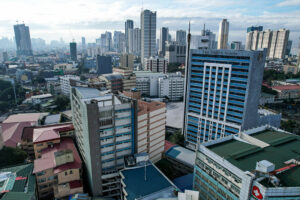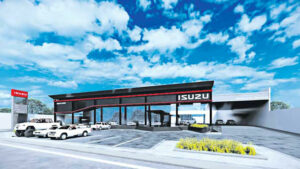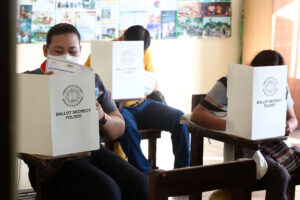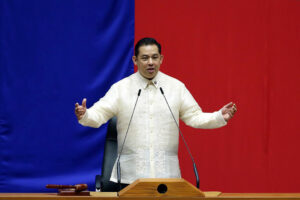PHL economic growth slows in Q1

THE PHILIPPINE ECONOMY grew by a weaker-than-expected 5.4% in the first quarter, reflecting heightened uncertainty arising from the Trump administration’s tariffs.
Data from the Philippine Statistics Authority showed that gross domestic product (GDP) expanded by 5.4% in the January-to-March period, sharply slowing from the 5.9% expansion in the same quarter last year.
This was also well-below the 5.8% median forecast of 15 economists in a BusinessWorld poll last week but faster than the revised 5.3% GDP in the fourth quarter of 2024.
On a seasonally adjusted quarterly basis, GDP expanded by 1.2%, decelerating from the revised 1.5% in the fourth quarter.
“While this pace falls short of our initial expectations, it reflects developments from the broader global context of tempered economic activity amid persistent uncertainties,” Department of Economy, Planning, and Development (DEPDev) Undersecretary for Policy and Planning Group Rosemarie G. Edillon said at a briefing on Thursday.
The first-quarter print was also below the government’s target range of 6-8% for the year.
Ms. Edillon said the economy should grow by at least 6.2% in the remaining three quarters to reach at least 6% growth by yearend.
She said the Development Budget Coordination Committee is scheduled to meet later this month to review the macroeconomic assumptions for this year.
First-quarter GDP growth was mainly fueled by faster public spending and household consumption.
Government spending jumped by 18.7% in the first three months of the year, faster than the 2.6% a year ago and 9% in the fourth quarter. This was the fastest clip since the second quarter of 2020.
The National Government frontloaded infrastructure spending ahead of the 45-day election ban on public works that started on March 28.
“Actually, for the entire year of 2025, there will still be substantial growth from government final consumption expenditure, again just looking at the disbursement program for the year,” Ms. Edillon said.
At the same time, household final consumption expenditure, which accounts for over 70% of the economy, grew by 5.3% annually from the 4.7% print in the fourth quarter.
“For household final consumption expenditure, what affects it really is, of course, the interest rates and then the inflation rate. And since we have been seeing easing inflation, we are hopeful that this will continue, and will impact positively on the household final consumption,” Ms. Edillon said.
Inflation averaged 2.2% in the first three months of the year, as food and transport costs fell.
The Bangko Sentral ng Pilipinas (BSP) cut its benchmark rate by 25 basis points (bps) to 5.5% at its April meeting. BSP Governor Eli M. Remolona, Jr. told Bloomberg on Wednesday that they are open to cutting rates by a further 75 bps this year amid cooling inflation.
TRADE WAR JITTERSThe DEPDev official noted investments and external trade offered a “mixed picture” in the first quarter.
“We’re seeing that it’s not really the trade war per se, but it’s really because of the anticipation of uncertainty in global trade, and therefore a lot more imports were front-loaded during the first quarter,” Ms. Edillon said.
Total exports growth slowed to 6.2% in the January-to-March period from 8.1% in the same period last year. Quarter on quarter, it picked up from 3.2%.
“The external sector’s performance reflects business strategies that were employed in anticipation of greater uncertainty in global trade. Thus, even with the strong (quarter-on-quarter) growth of exports (6.2% from 3.2%), net exports contracted sharply by -19.9% from its previous performance of -1.4%,” she said.
Imports increased by 9.9% in the first quarter, faster than the 2.2% in the same period last year and 2.7% in the fourth quarter.
Since he took office in late January, US President Donald J. Trump’ tariff threats sparked uncertainty and rattled markets around the world
In April, the US implemented a 10% baseline tariff on all its trading partners, while the higher reciprocal tariffs on some countries have been paused until July.
Gross capital formation, the investment component of the economy, grew by 4% in the first quarter, faster than the 0.8% a year ago but slower than the 5.5% in the fourth quarter.
“The reason for slower growth is because of the substantial drawdown in investments,” Ms. Edillon said, noting that fixed capital formation accelerated to 5.9%, from 2.3% in the same period in 2024.
She also noted a substantial drawdown in inventories (-98%), after a significant buildup in the last quarter of 2024.
“They’re kind of anxious probably that prices might increase or there might be some problems with the supply chain going forward, and therefore they already did the investments or the spending during first quarter,” Ms. Edillon said.
On the supply side, the services sector, which made the biggest contribution among major industries, expanded by 6.3% in the first quarter, easing from 7% a year ago.
The industry sector grew by 4.5% in the first quarter, slowing from 5.2% a year ago.
Agriculture, forestry, and fishing expanded by 2.2% in January to March, improving from the 0.5% growth in the same period a year ago.
Gross national income posted an annual 7.5% growth in the first quarter, slightly lower than the 9.9% rise a year ago.
Net primary income went up by 24.6% in the first quarter, lower than the 57.8% in the same quarter in 2024.
Ms. Edillon said the first-quarter economic data were not a disappointment, as global uncertainty was being seen as early as January.
Despite the lower-than-expected GDP growth, Ms. Edillon said the Philippines ranked second among Asian neighbors that have released first-quarter results, behind only Vietnam (6.9%) and tying China (5.4%). The Philippines was ahead of Indonesia (4.9%) and Malaysia (4.4%)
“There are actually signs that the economy is still very resilient, like domestic demand is still strong… But of course, global demand is not really well — it’s in a period of volatility,” she said.
Finance Secretary Ralph G. Recto said performance highlights the “continued strength and resilience” of the economy amid rising uncertainty.
“Our growth is strong, inflation continues to ease, private consumption is rising, and our job market remains vibrant. These are clear signals of accelerating domestic demand ahead, which is our strongest shield against external headwinds and trade wars,” Mr. Recto said.
‘LACKLUSTER’Analysts were underwhelmed by the first-quarter economic data and expect the central bank to continue easing to support growth.
“Despite household spending finally improving and pre-election spending by the government being punchy, growth underperformed relative to expectations,” HSBC economist for ASEAN Aris D. Dacanay said.
Mr. Dacanay said he expects Philippine growth to weaken in the second half as trade uncertainties weigh on the global economy.
“With growth expected to be below the government’s 6-8% target band, we expect the BSP to continue its easing cycle. More specifically, we see the BSP cutting its policy rate to 5% by yearend to support growth,” he added.
The BSP’s next policy meeting is on June 19.
Oxford Economics Lead Economist Sunny Liu said GDP is now expected to grow by 5.5% this year, after the lower-than-expected first-quarter print.
“To support growth, we expect the central bank to maintain an accommodative monetary stance, with another 25-bp rate cut in the second half of the year. Heightened external uncertainty, and its adverse effects on investment, should weigh on growth,” she said.
ANZ economist Arindam Chakraborty and Chief Economist for Southeast Asia and India Sanjay Mathur said the GDP growth was “lackluster.”
They noted that private consumption growth was still below the pre-pandemic five-year average growth rate of 6.2%. The uptick in consumer spending was also driven by favorable base effects, they added.
ANZ economists now expect Philippine GDP to expand by 5% this year, noting that external demand and investments are likely to soften amid slowing global growth.
“As of now, we expect two more rate cuts by the BSP in 2025 with a terminal rate of 5%,” they said.
For Chinabank Research, the uptick in household consumption provided some optimism for sustained growth.
However, it said external trade may remain a “weak spot” as the country deals with higher US tariffs and a possible global slowdown.
“The weaker-than-expected Q1 GDP print, along with easing inflation, boosts the case for an interest rate cut from the BSP,” Chinabank Research added. — Aubrey Rose A. Inosante




